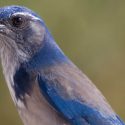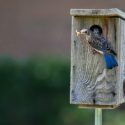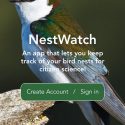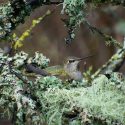 Photo ©
Keith Williams
Photo ©
Keith Williams

Farewell, Western Scrub-Jay!
We have an important update for you those of you living in the Western Scrub-Jay’s range: this species was recently split into two distinct species. Perhaps you have noticed differences between the “coastal” form (now the California Scrub-Jay) and the “interior” form (now Woodhouse’s Scrub-Jay); the California Scrub-Jay is darker and described as having a bold personality, while the Woodhouse’s Scrub-Jay is paler, has a thinner bill, and tends to be more shy and inconspicuous.
The American Ornithologists’ Union has been considering this split for several years. The split became official after genetic research demonstrated that the two species rarely interbreed where they come into contact with each other in western Nevada. In most of California, and all of Oregon and Washington, you will be reporting California Scrub-Jays from now on. If you live in Nevada, Arizona, Utah, Colorado, New Mexico, or Texas, then Woodhouse’s Scrub-Jays are the scrub-jays you’re seeing.
What do you need to do?
In most cases, nothing. As always, NestWatch will only show you geographically-relevant species when you are entering your nests, so unless you live in the small range of overlap in western Nevada, your species menu will highlight the appropriate choice. We will soon be updating historical nest records to reflect this change, so you do not need to edit previous records. We could really use photos of both species’ nests and eggs, so we’re asking everyone with photos to please share them with us.

Helping Behavior in Eastern Bluebirds
In contrast to Western Bluebirds, Eastern Bluebirds rarely have helpers at the nest. However, this breeding season NestWatch received two independent, confirmed reports of juvenile Eastern Bluebirds feeding their (presumed) younger siblings.
Glenda Simmons of Tallahassee, Florida, submitted a photo of a juvenile feeding its younger sibling. Glenda observed the behavior for six days and noted, “The first time I witnessed this I thought, perhaps it was a one-time event, since the mealworms happened to be close by. But then I saw the juvenile fly to the ground, where he plucked a spider from the grass and took it back to feed the nestlings inside the box.”
The second report came from Wild Birds Unlimited in Yorktown, Virginia. The store livestreams a nest cam and reported two juvenile Eastern Bluebirds feeding their younger siblings on a regular basis. You can see from their video that the juveniles aren’t just entering the nest to steal food from the nestlings, like this cunning juvenile Violet-green Swallow.
Research on helpers in breeding populations of Eastern Bluebirds is sparse. Anecdotal reports suggest that juveniles may be more of a hindrance than a help. Juvenile helpers can interfere with adults feeding the nestlings and they often do not adequately “prepare” the foods, i.e., some insects are still wriggling upon delivery!
Have you observed Eastern Bluebird helpers? Be sure to share your stories and images with us; we’d love to learn more about this phenomenon.

Help Test Our New App
The NestWatch app is under construction, and we’re looking for a few interested NestWatchers to join a small group of beta testers. We are seeking people of diverse backgrounds who have Android and iOS devices to help us test the app before it goes public. Whether you are rural or urban, new or experienced, or just like testing new technology, email us to get on the list. Testing will commence in September.

Home Tweet Home Winners
Betty Smith (via Facebook) said it best: “I wish I could vote for each of the photos, knowing behind each one are people who love and care about birds!” That was exactly our sentiment as we combed through 670 submissions, reading your stories and sharing in your discoveries. You all deserve a prize and a resounding, “thank you!”
But, a contest has to have winners, and the votes are in. Here are your 2016 Home Tweet Home official winners:
Congratulations to all of the winners! Thank you so much for participating. See all award winners and honorable mentions in our gallery of honorees.